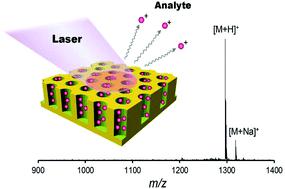Our official English website, www.x-mol.net, welcomes your feedback! (Note: you will need to create a separate account there.)
Direct nanoimprinting of nanoporous organosilica films consisting of covalently crosslinked photofunctional frameworks.
Nanoscale ( IF 6.7 ) Pub Date : 2020-07-10 , DOI: 10.1039/d0nr03272g Norihiro Mizoshita 1 , Yuri Yamada 1 , Masakazu Murase 1 , Yasutomo Goto 1 , Shinji Inagaki 1
Nanoscale ( IF 6.7 ) Pub Date : 2020-07-10 , DOI: 10.1039/d0nr03272g Norihiro Mizoshita 1 , Yuri Yamada 1 , Masakazu Murase 1 , Yasutomo Goto 1 , Shinji Inagaki 1
Affiliation

|
Nanoimprinting methods have been used widely to prepare various patterned or nanostructured thin films from inorganic or organic components. However, the accumulation of large functional aromatic groups in covalently crosslinked nanoimprints is challenging, due to the difficulty in controlling the fluidity and reactivity of the precursor films. In this work, nanoimprinting of naphthalimide-silica sol–gel films results in vertically oriented nanoporous structures consisting of covalently crosslinked UV-absorbing frameworks. The nanoimprinted films demonstrate potential as robust analytical substrates for laser desorption/ionization mass spectrometry (LDI-MS). The sol–gel polycondensation behavior of the precursors is examined using 29Si NMR spectroscopy to determine reaction conditions suitable for nanoimprinting. The inorganic–organic hybrid frameworks containing a high density of naphthalimide groups exhibit small volume shrinkage during the polycondensation reactions, which leads to desired nanoimprinting. Various bio-related compounds on the order of picomole to femtomole quantities are detectable by LDI-MS measurements using the nanoimprinted substrates. To improve their user-friendliness and signal intensity in LDI-MS analysis, the nanoimprinted substrates are patterned with surface-modified silica nanoparticles. The direct formation of surface nanostructures by nanoimprinting of functional organosilica films may open a new path to developing optically and electronically functional materials, thereby widening their utility.
中文翻译:

由共价交联的光功能框架组成的纳米多孔有机硅膜的直接纳米压印。
纳米压印方法已被广泛用于由无机或有机组分制备各种图案化或纳米结构的薄膜。然而,由于难以控制前体膜的流动性和反应性,因此在共价交联的纳米压印物中大官能芳族基团的积累是具有挑战性的。在这项工作中,萘二甲酰亚胺-二氧化硅溶胶-凝胶薄膜的纳米压印产生了垂直取向的纳米多孔结构,该结构由共价交联的紫外线吸收骨架组成。纳米压印膜证明有潜力作为激光解吸/电离质谱(LDI-MS)的可靠分析底物。前驱体的溶胶-凝胶缩聚行为使用29Si NMR光谱法确定适合纳米压印的反应条件。含有高密度萘二甲酰亚胺基团的无机-有机杂化骨架在缩聚反应过程中表现出较小的体积收缩,从而导致所需的纳米压印。通过使用纳米压印底物的LDI-MS测量,可以检测到苯甲酚到甲酚含量的各种生物相关化合物。为了在LDI-MS分析中改善其用户友好性和信号强度,使用表面改性的二氧化硅纳米粒子对纳米压印基材进行了图案化。通过功能性有机硅膜的纳米压印直接形成表面纳米结构可能为开发光学和电子功能材料开辟一条新途径,从而扩大了它们的用途。
更新日期:2020-07-16
中文翻译:

由共价交联的光功能框架组成的纳米多孔有机硅膜的直接纳米压印。
纳米压印方法已被广泛用于由无机或有机组分制备各种图案化或纳米结构的薄膜。然而,由于难以控制前体膜的流动性和反应性,因此在共价交联的纳米压印物中大官能芳族基团的积累是具有挑战性的。在这项工作中,萘二甲酰亚胺-二氧化硅溶胶-凝胶薄膜的纳米压印产生了垂直取向的纳米多孔结构,该结构由共价交联的紫外线吸收骨架组成。纳米压印膜证明有潜力作为激光解吸/电离质谱(LDI-MS)的可靠分析底物。前驱体的溶胶-凝胶缩聚行为使用29Si NMR光谱法确定适合纳米压印的反应条件。含有高密度萘二甲酰亚胺基团的无机-有机杂化骨架在缩聚反应过程中表现出较小的体积收缩,从而导致所需的纳米压印。通过使用纳米压印底物的LDI-MS测量,可以检测到苯甲酚到甲酚含量的各种生物相关化合物。为了在LDI-MS分析中改善其用户友好性和信号强度,使用表面改性的二氧化硅纳米粒子对纳米压印基材进行了图案化。通过功能性有机硅膜的纳米压印直接形成表面纳米结构可能为开发光学和电子功能材料开辟一条新途径,从而扩大了它们的用途。

























 京公网安备 11010802027423号
京公网安备 11010802027423号